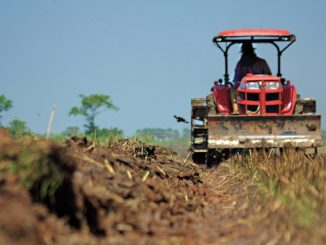Agricultural census made in 2010 provides trends of the farm holdings dynamic in France. Despite a decrease of 25% in the number of French farm holdings over the last decade, the overall volume of farm production has been maintained. However, according to a fact sheet issued by the statistic office of the French Ministry of Agriculture, the contribution to production among types of farm holdings has changed.

To determine the economic dimension of farms, farming statisticians summon all outputs, because the use of agricultural areas is not sufficient to obtain a relevant assessment (i.e. case of non-soil farms). Putting a coefficient on each unit of area of production gives a standard gross output (SGO) that allows classifications to be made that are not based on economic outcome but rather on potential production without aid.
The SGO criteria allows to farm classification according to their specialisation level as well as in the FADN database. A farm is considered as specialised in an area if the SGO of the concerned output is more than two thirds of the total. So a small farm has a SGO <25K €, a middle one has between 25 and 100K € , a large one has >100K € and a very large one >250 K €.
Small, middle and large farm holdings
More than 97% of potential production as measured by the economic dimension of farms is concentrated in middle and large farms. Large farms now account for more than 80% compared to 73% in 2000, and the very large farms account for 45% compared to 37% in 2000. As a result, the share of mixed farms has decreased (mixed-crops or mixed-stock farming).
Other data issued by the first census trends in 2011 has already showed that the number of small and medium-scale farms had significantly declined, while those of large farms had been maintained and even increased for very large farms. The decrease has impacted livestock and mixed farming, with quasidisparition of small dairy and small cattle farms, while specialised farms in cereals and oilseeds have become the first category of French farm holdings, while dairy farms are second. Fewer small farms represent 36% farms compared to 42% in 2000 and manage 7% of the Utilised Agricultural Area (UAA).
Small farms still numerous
According to the SCO criteria, there were some 178,000 small farms in 2010. Although they decreased yearly on average by 4.4%, the statistic office stated that “they nevertheless still make up more than one third of the total farm count and more than one quarter of active farm workers. These people supply 13.4% of the volume of work measured in annual work units (AWU) which is just slightly lower than in 2000 (15.1%)”. It further added: “Although the economic importance of these small farms is low (2.8% of total SGO), their social and human signification is considerable, even more so when the proportion of people concerned is especially high in mountainous and disadvantaged areas.”
Note that the terms of this characterisation of small farms are quite different from those proposed by the European Commission for the CAP reform towards 2020. The latter includes a small farmers scheme which aims at simplifying – with a lump sum- the aid distribution for those receiving less than 1000 €.
Read more about social prospective of French farmers here (in French)





